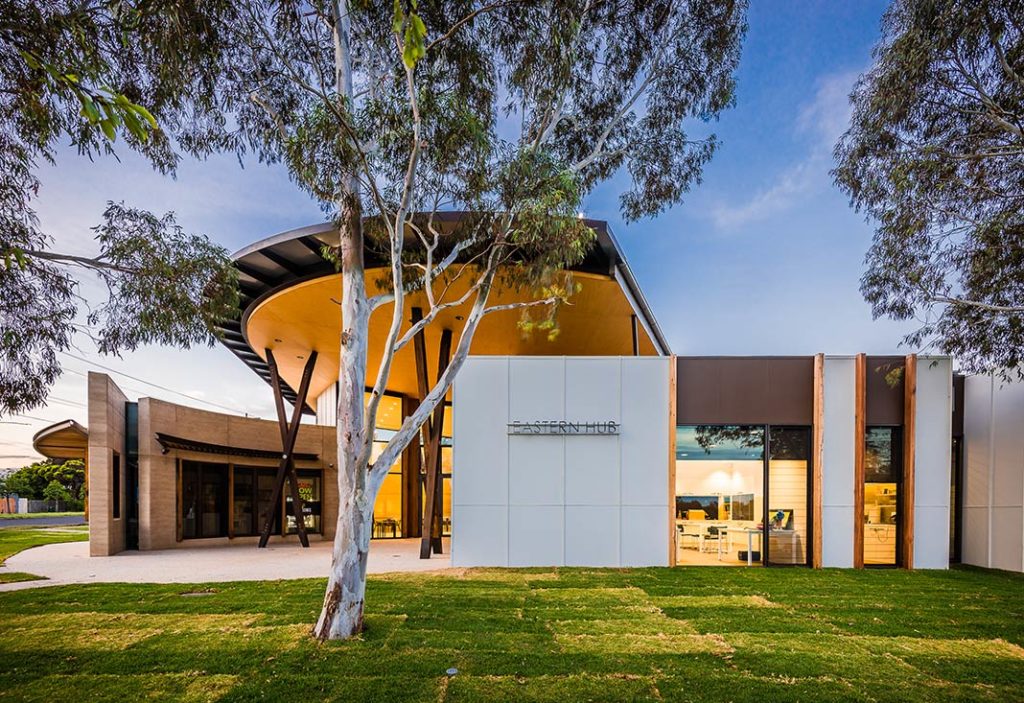
The Eastern Hub vision combines two core principles: ‘to provide first-class disability care within a deinstitutionalised setting’, and ‘to be inclusive for all by design and culture’. It provides a unique environment for human interaction as a key component of a holistic-care philosophy.
The Eastern Hub is an unmistakably public place with a prominent, entry providing clear views into the café, gallery, and garden courtyard; all spaces which are shared by Karingal and the community for recreation, training and functions. The shared arrangement supports managed and casual interaction between Karingal’s staff, clients and the public. The “soft-modern” building aesthetic creates an inviting environment that accommodates community and institutional requirements. The patina of undulating, layered wall forms complement the residential scale and character of the neighbourhood. An abundance of natural light, rammed earth walls and exposed recycled hardwood imbue the building with simple warmth and solidity reflective of the project philosophy.
The client, Karingal are a not-for profit organisation established by a group of local Geelong parents in 1952 to improve the quality of life for people with disabilities. “Karingal” is an Aboriginal word meaning “happy home” and the creation of healthy environments is a cornerstone of Karingal’s philosophy.
At the new Eastern Hub, Karingal provide specialised day care, training and personal development services for some of its “clients”. The building is designed specifically to meet the needs of people with a range of disabilities. Uniquely, the Eastern Hub is also a publicly accessible, community facility. The brief was to provide a welcoming place, inclusive by design and culture to be accessed by all people within the community. Karingal required the inclusion of innovative, activated spaces to attract the public, support community connection and enhance improved outcomes for both the Karingal client base and the local community. The whole facility and surrounding garden areas were required to be fully accessible and comply with the principles of universal and environmental design.
The solution to develope a deeper understanding of the project requirements was to become embedded in the development process for the new Eastern Hub facility. Project Architect Riordan Gough joined the project reference group which included Karingal clients and staff, as well as members of the local community. This experience allowed FMSA Architecture to meet more people and to develop and test the brief gradually over a longer period of about 2 years.
The solution to achieving a good balance of public / private areas was to develop a graduated spatial hierarchy that provides a clear indication of ownership and uses the architecture as a wayfinding tool. The shared spaces in the building such as the café, foyer/gallery, and garden courtyard are unambiguously designed and centrally located to encourage use by both the public and Karingal’s clients who have a range of mental and physical disabilities.
The activities in these spaces are a catalyst for social interaction and provide opportunities for people watching. While the building layout supports different groups of people to come together there are also clear opportunities for Karingal’s clients to retreat from public areas back to their own domain.
FMSA designed the building using warm materials like rammed earth and recycled timber to deinstitutionalise and soften this community facility. They used curved shapes and higher spatial volumes in the common central areas of the building to highlight the public nature of these shared spaces.
This is contrasted against the more austere pragmatic, rectilinear spaces of both the Karingal and community building wings. They benched the site to enable universal access from all surrounding footpaths to all building and garden areas. One wing of the building was used as a retaining wall and other garden walls were carefully sited to protect existing trees and provide wheelchair friendly paths.
The unique combination of functional requirements inherent in the project brief generated some challenges for the team in designing the Eastern Hub. Researching, collating and developing an understanding of the diverse needs of a wide range of people who were expected to use the new facility upon opening required significant time and effort. The long and elaborate pre-design phase was however an essential factor in the development of a relevant, responsive and thorough functional brief.
The project raised many social, psychological and practical issues. One challenge in particular was achieving the right balance between separation and connection for Karingal’s clients and the general public. While social inclusion and a healthy mixing between clients and public was a key project objective other considerations like security, privacy, retreat, management and the behavioral nuances of particular individuals also needed to be factored into the design. Attaining the right equilibrium between a functional, institutional appearance and a warm, inviting community aesthetic was also an enjoyable architectural challenge.
Achieving universal access on a sloping site was demanding and also increased construction costs.
In a building of this nature many of the spaces are required to be flexible and it is always a challenge to design inherent flexibility without resorting to a generic response.
The Eastern Hub client is Karingal – a not for profit organisation providing a range of services for people with a disability or mental illness, older Australians and those who are disadvantaged. Commencing services in Geelong in 1952, Karingal has establish programs and services that improve the quality of life for people with a disability in the community.
For over 60 years Karingal had occupied the site of the new Eastern Hub facility in East Geelong, operating from an outdated school structure that turned its back on the street, and in doing so isolated Karingal’s clients from the community.
The new Eastern Hub facility creates an opportunity for their clients and the wider community to come together as one community, supporting their organisational philosophy.
comments